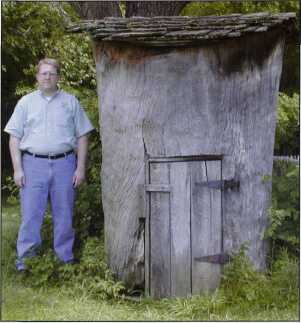T h e s y c a m o r e s m o k e h o u s e
Jane Addams opens window of reform for Danville women's social club
By Brent Wielt
If you visit Homestead Prairie Farm historic site at Rock Springs Nature Center near Decatur, you can't help but notice an unusual little outbuilding. Most people are puzzled, then amazed by it. What appears to be a tree stump is actually a smokehouse made from a hollowed out sycamore tree. Standing 7 feet high with an inside diameter of 44 inches, it is hard to miss. The smokehouse actually stands upside down, using the wide base of the trunk as the top to accommodate more meat during the smoking process.
The smokehouse's long history is a cherished part of the memories of the families who cared for and used the little building to feed themselves. Two sisters, Anna and Minna Reckwardt, who eventually owned the farm where the smokehouse was first placed, and Thelma Delong

Brent Wielt and the sycamore smokehouse at the Homestead Prairie Farm. Photo courtesy Brent Wielt
|
Reed whose father helped cut down the tree and convert it to a smokehouse, wrote down their families' memories of the little building. Their efforts helped preserve not only the building but its long history.
The smokehouse's history begins in 1887 when two friends and neighbors, Finnis Strope and Elmer Delong, found a big sycamore tree while hunting raccoons on Strope's land in the vicinity of Coulter Mill in northeast Macon County. With a team of horses and various hand tools the men cut the tree, hauled it to Strope's farmyard, enlarged the sycamore's already partially hollow interior, and attached a roof and door. While a trip to Decatur for nails was required, the lumber for the roof's shake shingles and batten door came from local trees and was milled nearby at the Reed Mill.
The smokehouse stayed in the Strope's farmyard, though later the property changed ownership. Edward Reckwardt purchased the farm in 1901, and the sycamore smokehouse passed to his daughters, Anna and Minna, at his death in 1934. The sisters cherished the building and in 1966, decided to share it with future generations, donating it to the Macon County Historical Commission.
The smokehouse was moved to a small museum at the Macon County Administration Building in downtown Decatur. In 1982 it was moved for the third and last time to Homestead Prairie Farm just outside Decatur. The first time the smokehouse was moved it required a team of horses; the last two times the modern services of a forklift and large truck made the journey much easier.
At its current location carpenters built a new door similar to the original, which was put in storage. In 1999 the corrugated metal roof, put on by the Reckwardt family in 1934, was replaced with more authentic wooden shake shingles. During the roof replacement an intact sub-roof was found; it was built with very wide boards and held on by handcut nails; we left it in place.
The sycamore tree smokehouse has grabbed the attention of many visitors at Homestead Prairie Park, especially children. They marvel at it size, stare at it in amazement, wonder how it was used, and stick their heads inside to see its blackened interior. Young and old alike marvel at this quaint, practical structure, and reflect on its long life and curious transformation from stately tree to a unique and beloved piece of vernacular architecture.
Brent Wielt is the Historic Sites Manager for the Macon County Conservation District. For more information about Homestead Prairie Farm go to www.maconcountyconservation.org.
ILLINOIS HERITAGE| 17
|

